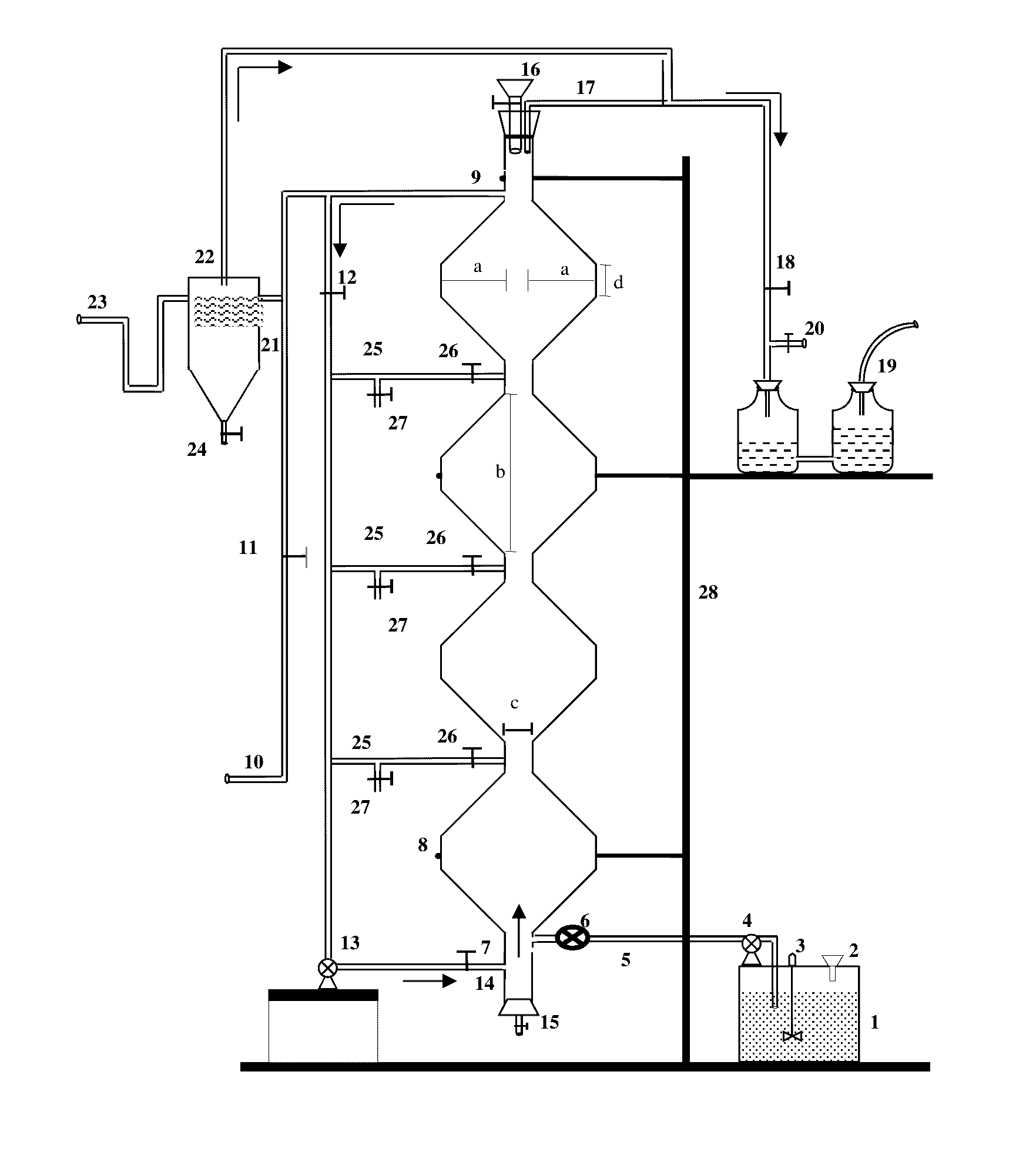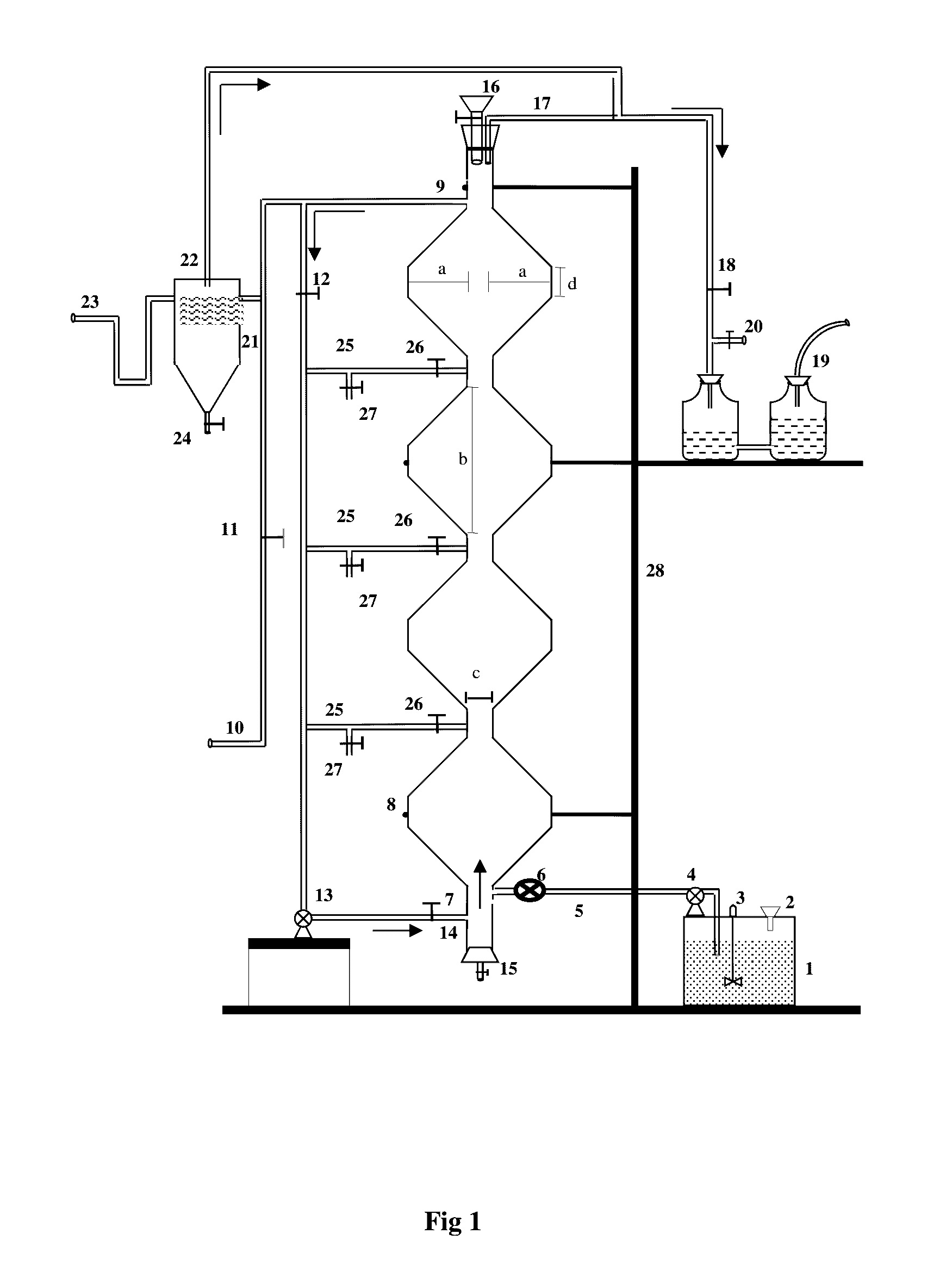Anaerobic column reactor for biodegradation of wastes and the process thereof
a technology of anaerobic column and waste, which is applied in the direction of biomass after-treatment, gas production bioreactors, biological treatment regulation, etc., can solve the problems of deteriorating the performance affecting the treatment efficiency of the reactor, and energy not recovered, so as to improve the removal rate of the substrate, improve the effect of mass transfer and enhance the contact of biomass substrates
- Summary
- Abstract
- Description
- Claims
- Application Information
AI Technical Summary
Benefits of technology
Problems solved by technology
Method used
Image
Examples
example 1
[0123]The prototype of present invention was operated in the laboratory for the treatment of food waste slurry with different slurry concentrations. Influent slurry characteristics for 20% slurry concentration were in the following range: chemical oxygen demand (COD): 35500 mg / l and total solids: 20000 mg / l. Physico-chemical characteristics of food waste is given in Table 2 whereas slurry characteristics and elemental analysis of waste slurry at 20% solids concentration are given in Table 3 and Table 4 respectively.
[0124]The ratio of total volatile acids (TVA) to the alkalinity was maintained below 0.4 throughout the study. This indicated proper balance between the reactor content, which did not necessitate the addition of alkalinity to the reactor system proving it economical. The volatile solids reduction of 96% was obtained at 5 d HRT. The specific biogas yield at optimum HRT of 5 d was observed to be 0.35 cum.CH4 / kgCODr.d with 69% methane content in the biogas. Biogas generation...
example 2
[0126]The prototype of present invention was operated at various HRTs by varying flow rate of food waste slurry. It was observed that the quality of effluent went on deteriorating as the flow rate of influent wastewater went on increasing. It was observed that after a particular HRT of 5 d, the increase in HRT didn't yield the considerable improvement in effluent quality. Below HRT of 5 d, the pH of treated effluent drastically changed to acidic (pH<5.2). On the other hand, lower HRT than 5 d hampered the effluent quality with COD reduction efficiency reduced to less than 50%. Hence, from the viewpoint of techno-economic effectiveness, HRT of 5 d was established as an appropriate HRT for the reactor while treating municipal wastewater.
example 3
[0127]The influent slurry concentration was maintained at 20%. However, the parameters such as pH, total COD (CODt) and volatile fraction of solids varied in the range of 6.8-7.6, 18000-22000 mg / L, and 65-75% respectively. Performance evaluation study over a period of 200 days demonstrated that although influent feed characteristics and concentrations were changing diurnally, the treated effluent quality at the particular HRT was consistent. The values of pH, biogas generation rate and CODt reduction were obtained to be 7.5, 0.34 m3CH4 / kgCODr and 75% respectively during the steady state period of operation. This has confirmed that the reactor is robust enough to handle the variation in wastewater quality and influent feed for yielding consistent effluent quality. This facet of the reactor is quite useful to the industries where variation in the feed quality is frequent. Performance of the anaerobic column reactor with respect to solids reduction and biogas generation is indicated in...
PUM
| Property | Measurement | Unit |
|---|---|---|
| hydraulic retention time | aaaaa | aaaaa |
| concentration | aaaaa | aaaaa |
| concentration | aaaaa | aaaaa |
Abstract
Description
Claims
Application Information
 Login to View More
Login to View More - R&D
- Intellectual Property
- Life Sciences
- Materials
- Tech Scout
- Unparalleled Data Quality
- Higher Quality Content
- 60% Fewer Hallucinations
Browse by: Latest US Patents, China's latest patents, Technical Efficacy Thesaurus, Application Domain, Technology Topic, Popular Technical Reports.
© 2025 PatSnap. All rights reserved.Legal|Privacy policy|Modern Slavery Act Transparency Statement|Sitemap|About US| Contact US: help@patsnap.com


